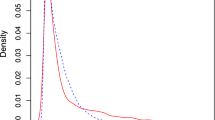Abstract
An original approach to simulation modeling of the HIV/AIDS epidemic is proposed. This approach uses survivor functions estimated from cohort studies conducted with seropositive and AIDS-diagnosed individuals. The model can be considered an alternative to the usual Markov models and accounts for time-dependent HIV progression to AIDS, and AIDS progression to death. By using various forms of survivor functions, it can also easily be extended to accommodate natural history events, as well as long-term survivors and cofactor effects, when appropriate data are available.
Similar content being viewed by others
References
Postma MJ, Tolley K, Liedl RM, et al. Hospital care for persons with AIDS in the European Union. Health Policy 1997; 41: 157–176.
Shahani AK, Brailsford SC, Roy RB. HIV and AIDS patient care. Operational models for resource planning. In: Kaplan EH, Brandeau ML (Eds.) Modeling the AIDS Epidemic Planning, Policy and Prediction. New York: Raven Press, 1994: 179–198.
Bailey NTJ. Estimating HIV incidence and AIDS projections. Prediction and validation in the public health modelling of HIV/AIDS. Stat Med 1994; 13: 1933–1943.
Jacquez JA, Simon CP. Qualitative theory of compartmental systems. SIAM Rev 1993; 35: 43–79.
Schinaia G. Some remarks on time-dependency in epidemic models. In: Annali del Dipartimento di Studi Geoeconomici, Statistici, Storici per l'Analisi Regionale Rome: Univ di Roma La Sapienza, 1997: 229–234.
Rossi C. A stochastic Mover-Stayer model for HIV epidemic. Mat Biosci 1991; 107: 521–545.
Rossi C, Schinaia G. Modeling Italy's regional data of the HIV/AIDS epidemic. In: Anderson JG, Katzper M (Eds.) Simulation in the Medical Sciences. San Diego: Soc for Computer Simulation, 1996: 64–70.
Rossi C, Schinaia G. The Mover-Stayer model for the HIV/AIDS epidemic in action. Interfaces 1998; 28(3): 127–143.
Gard TC. Introduction to Stochastic Differential Equations. New York: Marcel Dekker, 1988.
Heesterbeck JAP, Dietz K. The concept of R 0 in epidemic theory. Statist Nederlandica 1996; 50(1): 89–110.
Centro Operativo AIDS Sindrome da immunodeficienza acquisita in Italia: aggiornamento dei casi notificati al 30 settembre 1997. Rome: Istituto Superiore di Sanità, 1998.
Heisterkamp S, Jager JC, Ruitenberg EJ, van Druten JAM, Downs AM. Correcting reported AIDS incidence: A statistical approach Stat Med 1989; 8: 963–976.
Satten GA, Longini IM. Markov chain with measurement error: Estimating the ‘true’ course of a marker of the progression of human immunodefficiency virus disease. Appl Statist 1996; 45(3): 275–309.
Hendricks JCM, Satten GA, Longini IM, et al. Use of immunological markers and continuous-time Markov models to estimate progression of HIV infection in homosexual men. AIDS 1996; 10.
Muñoz A, Xu J. Models for the incubation of AIDS and variations according to age and period. Stat Med 1996; 15: 2459–2473.
Bacchetti P, Jewell NP. Nonparametric estimation of the incubation period of AIDS based on a prevalent cohort with unknown infection times. Biometrics 1991; 47: 947–960.
Taylor JMG, Muñoz A, Bass SM, Saah AJ, Chmiel JS, Kingsley LA. Estimating the distribution of times from HIV seroconversion to AIDS using multiple imputation: multicenter AIDS cohort study. Stat Med 1990; 9: 505–514.
Pasqualucci C, Ravà L, Rossi C, Schinaia G. Estimating the size of the HIV/AIDS epidemic: Complementary use of the empirical Bayesian back-calculation and the Mover-Stayer model for gathering the largest amount of information. Simulation 1998; 71(4): 213–227.
Author information
Authors and Affiliations
Rights and permissions
About this article
Cite this article
Schinaia, G. Modeling the HIV/AIDS epidemic via survivor functions. Eur J Epidemiol 16, 573–579 (2000). https://doi.org/10.1023/A:1007663607280
Issue Date:
DOI: https://doi.org/10.1023/A:1007663607280




